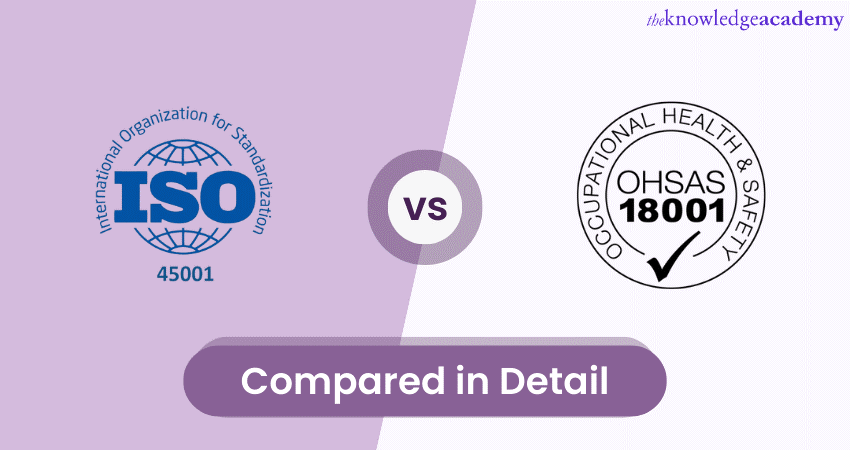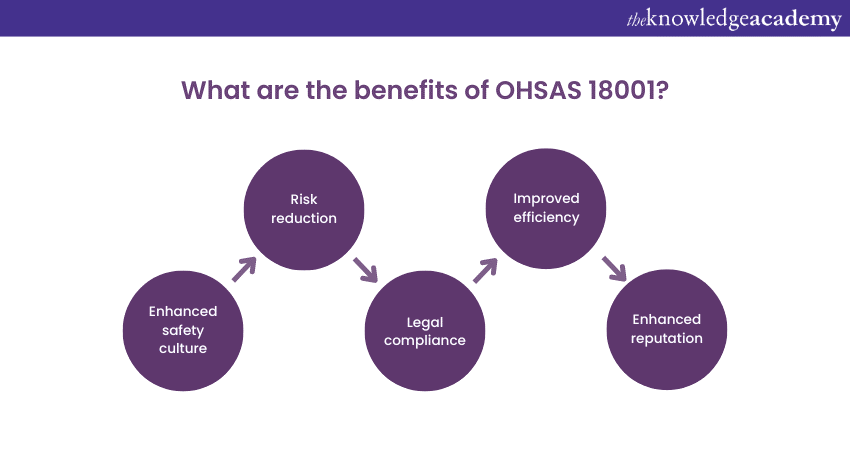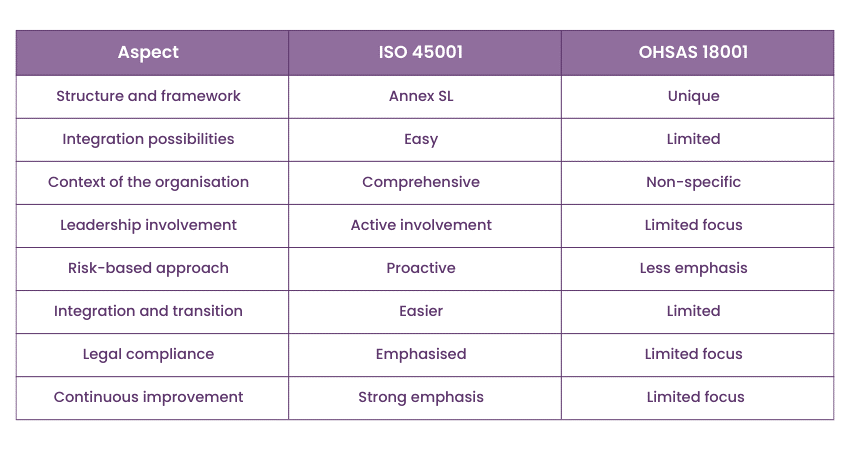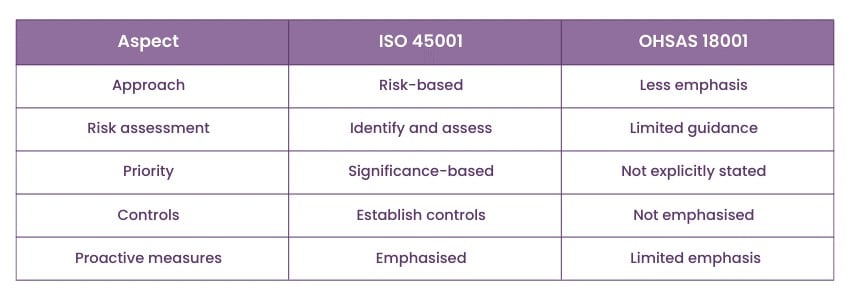We may not have the course you’re looking for. If you enquire or give us a call on +27 800 780004 and speak to our training experts, we may still be able to help with your training requirements.
Training Outcomes Within Your Budget!
We ensure quality, budget-alignment, and timely delivery by our expert instructors.

ISO 45001 and OHSAS 18001 are two prominent occupational health and safety management standards. Choosing one among these standards can be a challenging task for organisations. Learning the differences between ISO 45001 vs OHSAS 18001 can help simplify the decision-making process.
According to Statista, about 123 workers died from fatal workplace injuries in Great Britain in 2022. Implementing a safety management standard like ISO 45001 or OHSAS 18001 can help reduce and prevent such tragedies. This blog on ISO 45001 vs OHSAS 18001 explores the differences between ISO 45001 and OHSAS 18001, two widely recognised occupational health and safety standards.
Table of Contents
1) Introduction to ISO 45001
2) An introduction to OHSAS 18001
3) Key differences between ISO 45001 vs OHSAS 18001
a) Structure and framework
b) Context of the organisation
c) Leadership and worker participation
4) Conclusion
Introduction to ISO 45001

It is an internationally recognised standard for occupational health and safety management systems. It provides a systematic framework to identify, control, and reduce risks, ensuring a safe and healthy work environment.
ISO 45001 helps organisations establish a proactive approach towards occupational health and safety, demonstrating their commitment to the well-being of employees and stakeholders. The ISO 45001 Benefits are plenty which makes it all the more useful and effective for maintaining health and safety at the workplace.
An introduction to OHSAS 18001

OHSAS 18001, also known as Occupational Health and Safety Assessment Series, is a globally recognised standard for occupational health and safety management systems. It helps an organisation with a framework for the following processes:
a) Identify and control hazards
b) Reduce risks
c) Improve overall safety performance
OHSAS 18001 helps organisations prioritise the health and well-being of their employees while complying with relevant legal and regulatory requirements.
Secure your ISO 45001 Certification today and lead your organization to safer, compliant work practices. Start your certification journey now!
Key differences between ISO 45001 vs OHSAS 18001
ISO 45001 and OHSAS 18001 are two prominent standards focusing on occupational health and safety management systems. While they share the common objective of ensuring workplace safety, there are several key differences that organisations should be aware of when choosing between the two. Let's explore the difference between ISO 45001 and OHSAS 18001 in detail.

Structure and framework
ISO 45001 and OHSAS 18001 have notable differences in their structure and framework. These differences affect how organisations implement and integrate these standards into their occupational health and safety management systems. Here are the key differences:
a) ISO 45001 adheres to the Annex SL framework, ensuring a standardised structure aligned with other ISO management system standards.
b) OHSAS 18001, on the other hand, possesses its own distinct structure that is not aligned with Annex SL.
c) ISO 45001 facilitates easier integration with other ISO standards, like ISO 9001 and ISO 14001.
d) In contrast, OHSAS 18001 does not offer the same level of integration possibilities as ISO 45001.
Understanding these differences is crucial for organisations seeking to adopt the most suitable standard for their occupational health and safety management needs.
Empower yourself with the essential skills and knowledge to drive a culture of safety and well-being with our ISO 45001 Foundation Training – Signup now!
Context of the organisation
ISO 45001 and OHSAS 18001 exhibit several key differences. Here's a breakdown of these distinctions:
a) ISO 45001 emphasises understanding the needs and expectations of workers, regulatory bodies, stakeholders, and interested parties.
b) Organisations must comprehensively analyse internal and external factors affecting occupational health and safety performance.
c) ISO 45001 also mandates identifying and assessing workplace health and safety opportunities.
d) On the other hand, OHSAS 18001 does not specifically address the context of the organisation in relation to occupational health and safety.
e) It lacks the same level of requirements for analysing internal and external factors and assessing risks and opportunities.
f) These differences are crucial in guiding organisations to choose the most appropriate standard for effectively managing their occupational health and safety requirements.
These differences play a crucial role in guiding organisations to choose the most appropriate standard for effectively managing their occupational health and safety requirements.
Leadership and worker participation
ISO 45001 and OHSAS 18001 display notable differences when it comes to leadership and worker participation. Let's explore these distinctions:
a) ISO 45001 emphasises the active involvement of top management in the occupational health and safety management system.
b) Leadership must demonstrate commitment by promoting worker participation, consultation, and engagement.
c) ISO 45001 encourages the establishment of defined roles, responsibilities, and authorities for ensuring effective occupational health and safety management.
d) On the other hand, OHSAS 18001 does not have the same explicit focus on leadership involvement and worker participation.
e) It may not provide the same level of guidance for top management to engage in the occupational health and safety system actively.
f) Understanding these differences is crucial for organisations deciding between ISO 45001 and OHSAS 18001 to foster a culture of leadership and worker participation in their occupational health and safety practices.
Learn how to conduct ISO 45001 certification audit with our ISO 45001 Lead Auditor course.
Risk-based approach
ISO 45001 and OHSAS 18001 demonstrate distinct approaches to risk management. Let's delve into these differences:

a) ISO 45001 promotes a risk-based approach to occupational health and safety management.
b) It requires organisations to identify and assess risks and opportunities, prioritise actions based on their significance, and establish controls to mitigate risks.
c) ISO 45001 emphasises the importance of proactive measures and continuous improvement to effectively address occupational health and safety risks.
d) Conversely, OHSAS 18001 does not explicitly emphasise a risk-based approach to the same extent.
e) It may not provide the same level of guidance for organisations to identify and manage occupational health and safety risks systematically.
Understanding these differences is essential for organisations choosing between ISO 45001 and OHSAS 18001 to adopt an effective risk management approach in their occupational health and safety practices.
Integration and transition
ISO 45001 and OHSAS 18001 exhibit differences in terms of integration and transition. Let's explore these variances:
a) ISO 45001 allows easier integration with standards like ISO 9001 and ISO 14001.
b) Organisations certified to these standards can leverage their existing systems and processes when implementing ISO 45001 Implementation.
c) It enables a more seamless transition for organisations that align their occupational health and safety management systems with other management system standards.
d) On the other hand, OHSAS 18001 does not offer the same level of integration possibilities.
e) Organisations transitioning from OHSAS 18001 to ISO 45001 may require more effort and adjustments due to the differences in structure and requirements.
Considering these differences is crucial for organisations looking to integrate their occupational health and safety management systems or transitioning from one standard to another.
Elevate your organisation's safety standards with our ISO 45001 Training Courses and unlock a new era of occupational health and safety excellence!
Legal compliance
ISO 45001 and OHSAS 18001 demonstrate differences in terms of legal compliance. Here's how they compare:
a) ISO 45001 emphasises the importance of legal and regulatory compliance regarding occupational health and safety.
b) It requires organisations to establish processes to identify and understand applicable legal requirements and ensure compliance.
c) ISO 45001 promotes a proactive approach to compliance, including developing legal registers and regular compliance status reviews.
d) In contrast, OHSAS 18001 does not have the same explicit focus on legal compliance.
e) While OHSAS 18001 may encourage compliance with relevant legal requirements, it does not provide the same guidelines as the ISO 45001 Requirements.
Understanding these differences is essential for organisations aiming to manage legal compliance related to occupational health and safety effectively. Choosing the appropriate standard depends on the organisation's legal requirements and compliance priorities.
Continuous Improvement
Both ISO 45001 and OHSAS 18001 differ in their approach to continuous improvement. Let's explore these distinctions:
a) ISO 45001 strongly emphasises continual improvement of occupational health and safety performance.
b) It requires organisations to establish processes for monitoring, measuring, analysing, and evaluating their performance.
c) ISO 45001 promotes using performance indicators and regular audits to identify areas for improvement.
d) It encourages organisations to set objectives and targets, implement corrective actions, and strive to enhance occupational health and safety performance.
e) Conversely, OHSAS 18001 does not explicitly emphasise continuous improvement to the same extent.
f) While it may encourage organisations to monitor and review their systems, it does not provide the same level of guidance and requirements for continual improvement.
Understanding these differences is crucial for organisations seeking to foster a culture of continuous development in their occupational health and safety practices. ISO 45001 may be the preferred choice for organisations committed to ongoing enhancement in performance.
Become a trusted leader in occupational health and safety by mastering the art of implementing ISO 45001 with our ISO 45001 Lead Implementer Training - Signup now!
Conclusion
We hope you liked reading and understanding the differences between ISO 45001 vs OHSAS 18001. From organisational context to continuous improvement, these standards present distinct approaches. Understanding the differences between OHSAS 18001 vs ISO 45001 is crucial to making informed decisions and choosing the most suitable standard that aligns with your specific needs and goals.
Sign up with our ISO 45001 Internal Auditor course to learn the considerations to pay attention to during the auditing process.
Frequently Asked Questions
Upcoming Health & Safety Resources Batches & Dates
Date
 ISO 45001 Foundation
ISO 45001 Foundation
Mon 10th Feb 2025
Mon 19th May 2025
Mon 8th Sep 2025
Mon 8th Dec 2025







 Top Rated Course
Top Rated Course



 If you wish to make any changes to your course, please
If you wish to make any changes to your course, please


